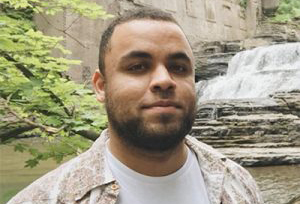Darien Williams, a recent master’s graduate in City and Regional Planning from the University of North Carolina at Chapel Hill, was one of two students to receive an Education and Workforce Development Grant from the Coastal Resilience Center of Excellence (CRC) during the 2016-2018 school years. He reflected on her work with the CRC and other projects focusing on resilience.
Describe the work you did with the CRC during graduate school and how it shaped your career goals.

My work with the CRC took two forms; The first being engaging the world of resilient design education under the guidance of CRC Director Dr. Gavin Smith and UNC Professor Dr. Mai Thi Nguyen, alongside peers and Education and Workforce Development Grant Fellows Ashton Rohmer and Colleen Durfee. Through our investigation, we were able to uncover institutional strengths and challenges of departments attempting to incorporate hazard and climate resilience into the curricula of planning, engineering, architecture, landscape architecture and building science programs across the United States. As a new master’s student who would eventually decide to pursue a Ph.D., this project helped me understand the landscape I was about to enter, while also contributing to a larger understanding of an important shift in the way design professionals think about education.
Alongside this project, following Hurricane Matthew in 2016, I worked with the Hurricane Matthew Disaster Recovery and Resilience Initiative (HMDRRI), a project run through CRC. The realms of planning and policymaking were distant and abstract for me until this experience, which threw me into the middle of enormous recovery and climate-related planning conversations for six rural communities across Eastern North Carolina. I continue to draw on these experiences, which have informed my perspective on governance, community development, climate justice and the role of city planners. My current research would be impossible to meaningfully undertake without the depth of experience this work afforded me.
Can you talk about your experiences working in eastern North Carolina for the Hurricane Matthew recovery initiative?
My particular interest in community engagement and disparate impacts brought me to work with HMDDRI, which placed our student team in a position to witness just what federal, state, and local collaboration looked like. Some of the process seemed messy, unclear and surprising – a current fact of disaster recovery that mirrors the complexity of local issues that exist even before such events take place. Everything was useful. Everyone was useful. As a planner, I could be at a public meeting, in a church, at a fish fry event, on the porch of someone’s house or out in the woods when I would encounter interesting, meaningful information.
HMDRRI brought me to my first experiences organizing public meetings, creating engaging material for community input, guiding discussion in a focus group, understanding how to deeply listen and discern expressed needs, and formulating this into a coherent plan or document.
What part of your time with the CRC sticks with you the most?
Prior to joining UNC-Chapel Hill, I felt somewhat knowledgeable about general challenges in city planning, but my work with the CRC opened my eyes to the massive issues communities face due to natural hazards. Our work also helped me deeply understand the importance of mobilizing a workforce of practitioners committed to understanding and solving these problems; that we are only just beginning, and climate change-related issues will only increase in threat in the immediate future.
Can you talk about the work you’ve done with the Southeast Disaster Recovery Partnership?
The Southeast Disaster Recovery Partnership is an organization that connects state, local and private industry leaders to work together to solve greater, region-level challenges in disaster recovery. As program and research assistant, I worked under the guidance of Amanda Martin, AICP, coordinating meetings of state officials across North Carolina, South Carolina, Georgia and Florida. Leaders in each of these states led NOAA-funded projects to make their states and communities more resilient. Part of my work included meeting their information needs by producing things such as an investigation on public-private partnerships in disaster recovery, as well as coordinating monthly check-ins to support the progress of state projects.
What does the future hold for you?
The CRC provided a foundation on which I am building my future work. Currently, I am in the first semester of a Ph.D. program in urban planning at the Massachusetts Institute of Technology, where I continue to investigate opportunities for resilience from a local to a regional scale. Despite the tragedy of large-scale disasters, these events can be teachable moments for the United States, and I am fully committed to using those real-world educational opportunities to the greatest extent.
